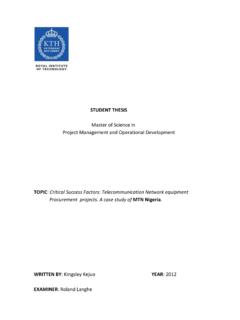Transcription of Gender Roles and Inequalities in the Nigerian Labour Market
1 The K4D helpdesk service provides brief summaries of current research, evidence, and lessons learned. Helpdesk reports are not rigorous or systematic reviews; they are intended to provide an introduction to the most important evidence related to a research question. They draw on a rapid desk-based review of published literature and consultation with subject specialists. Helpdesk reports are commissioned by the UK Department for International development and other Government departments, but the views and opinions expressed do not necessarily reflect those of DFID, the UK Government, K4D or any other contributing organisation. For further information, please contact Helpdesk Report Gender Roles and Inequalities in the Nigerian Labour Market Sue Enfield Institute of development Studies 21 May 2019 Question What level of participation in both formal and informal Labour markets are women across nigeria able to attain?
2 What are the barriers facing women in the Nigerian Labour Market ? What evidence exists of effective women s economic empowerment (WEE) interventions? Contents 1. Summary 2. Characteristics of the Nigerian Labour Market 3. Barriers facing women in the Nigerian Labour Market 4. Evidence of effective Women s Economic Empowerment (WEE) interventions 5. References 2 1. Summary of the Nigerian Labour force is female (World Bank, 2019). Women s participation in formal and informal Labour markets is on a positive trajectory and has been rising in both rural and urban areas through the period 1990-2009 but remains lower than that of males (Olowa & Adeoti 2014:73). Women who can work away from the home particularly in non-familial organisations; in remunerative jobs in the formal rather than in the informal economy; or regular and full-time jobs that are permanent and secure - are more likely to become empowered (Oluwagbemiga et al, 2016:76).
3 Most Nigerians work: with the largest population in Africa over 50% (87 million people) were of working age (between 15 and 64 years). In this group 53 million people were employed and less than 4 million (6%) of the active population were without a job and looking for work (World Bank, 2015:x). in nigeria , most employed individuals work for themselves, or their families or in informal conditions close to home. Some work several jobs and despite this many do not earn enough to escape poverty. Marginal improvement in economic growth1 has not yet delivered a positive impact on employment levels with just 8% of the adult population employed in the formal sector. Across the world, women juggle work with family and care responsibilities, and nigeria is no exception.
4 Early marriage and family formation play a critical role in women s access to jobs and it is a more significant issue for young women from poorer households than others. Although girls are more likely to leave school early than boys, they do not then get a job. Instead, young women are much more likely to marry early than men are. At age 20, less than 4% of men are married, compared to about 50% of women in rural areas. With early marriage comes early pregnancies and household responsibilities that effectively remove women from Labour Market opportunities. Women in nigeria are less likely to be active in the Labour Market ; more likely to be in lower-earning opportunities like farming and informal jobs; and earn less for a given level of education and experience than men of the same level.
5 There are barriers to entry into the Labour Market for women and to their successful participation within the Labour Market Girls entry into the workforce is conditioned by early marriage and starting a family A Gender gap in education limits the choice of occupation for women (completion rates of primary education for boys is about 80% while only 66% for girls) High levels of inequity in human development indicators between northern and southern states accentuate educational barriers to employment (42% of adults in the north had no education compared to 13% in the south) Lack of education and marginalisation from schools and skills acquisition programmes make it especially difficult for women with disabilities to gain employment Muslim women are less able to participate in a visible work force when compared with women in other religions 1 rise in GDP between Q3 2017 and Q3 2018 3 Women form the backbone of the agricultural sector, providing an estimated 60-80% of all Labour but have less access to resources and limited decision-making power over their plots resulting in a gendered gap in harvest value.
6 The high proportion of women involved in farming related activities ( ) thus holds most women in low-paid occupations. Women are more likely to be involved in small household enterprises and non-farm enterprises that show low productivity and dynamism (potential to grow, adapt and change). Within the world of work women s success is limited by lower levels of education; barriers in access to finance and digital connectivity that would open their access to Market information and mobile banking services. Women are more likely to become entrepreneurs than men out of economic necessity. But in business women make different strategic decisions since they are constrained by Gender -specific factors (household related demands, the contexts in which they operate, their assets).
7 These influence the decisions that female entrepreneurs make, choosing low risk sectors that can be entered with low level of investment. A Gender gap in profits as high as 39% is found between male and female led small and medium enterprises in nigeria . Government policies are dominated by interest in the formal sector, although women are to be found in far greater number in agriculture, non-farm enterprises and the informal sector. This is another example of Gender bias in Nigerian institutions where legal, political and cultural ceilings limit women s potential in the Labour Market . The net result is that almost twice as many women as men live below the poverty line. A small number of pilots have been trialled in nigeria and neighbouring countries of West Africa, to experiment with ways of supporting success for women in the Labour Market .
8 These provide promising practice from examples of: Providing cash injections to women s businesses (through cash transfer or business plan competitions) Innovative saving schemes to allow women to retain a greater share of their earnings Training to foster personal initiative and build an entrepreneurial mindset, proved to be more successful that traditional business training A job specific training to dismantle women s internal biases and perceptions that certain sectors are not open or accessible to employing women The literature makes frequent reference to the difficulty of gaining reliable statistical data from within nigeria although several studies used in preparing this report compared panel data from studies repeated at intervals.
9 It is assumed that the trends indicated are therefore reliable enough. A combination of published research by Nigerian authors and wider studies by teams from institutions (World Bank, ILO, FAO) informs the findings of this report. 2. Characteristics of the Nigerian Labour Market Nigerians rank unemployment as the most important challenge facing the country, well above poverty even though estimates are that one third of Nigerians live in poverty (World Bank, 2015:viii & ix). Although the country experienced quite high and stable economic growth in the years before 2015 this did not make a significant impact on poverty levels. Enhancing Financial Innovation & Access reports that nigeria is now out of the recession that began in 2016 (EFInA, 4 2018:11).
10 Marginal improvement in economic growth2 has not yet delivered a positive impact on employment levels with just 8% of the adult population employed in the formal sector3. work in their own business (non-farming) in their own business (farming related) and rely mainly upon farming for income (EFInA, 2018:12). ILO (2018) data shows that of the population aged over 15 years is employed in some form but men are more likely to be employed ( ) than women ( ) (ILOSTAT:2018). Inadequate job opportunities are core to high levels of poverty, regional Inequalities and social and political unrest. Economic growth has produced some more job and income opportunities, but this is outpaced by high growth in the working age population. Many workers are marginalised by low skills, with women especially trapped in low-productivity subsistence or low-paid activities (World Bank, 2015: viii).














